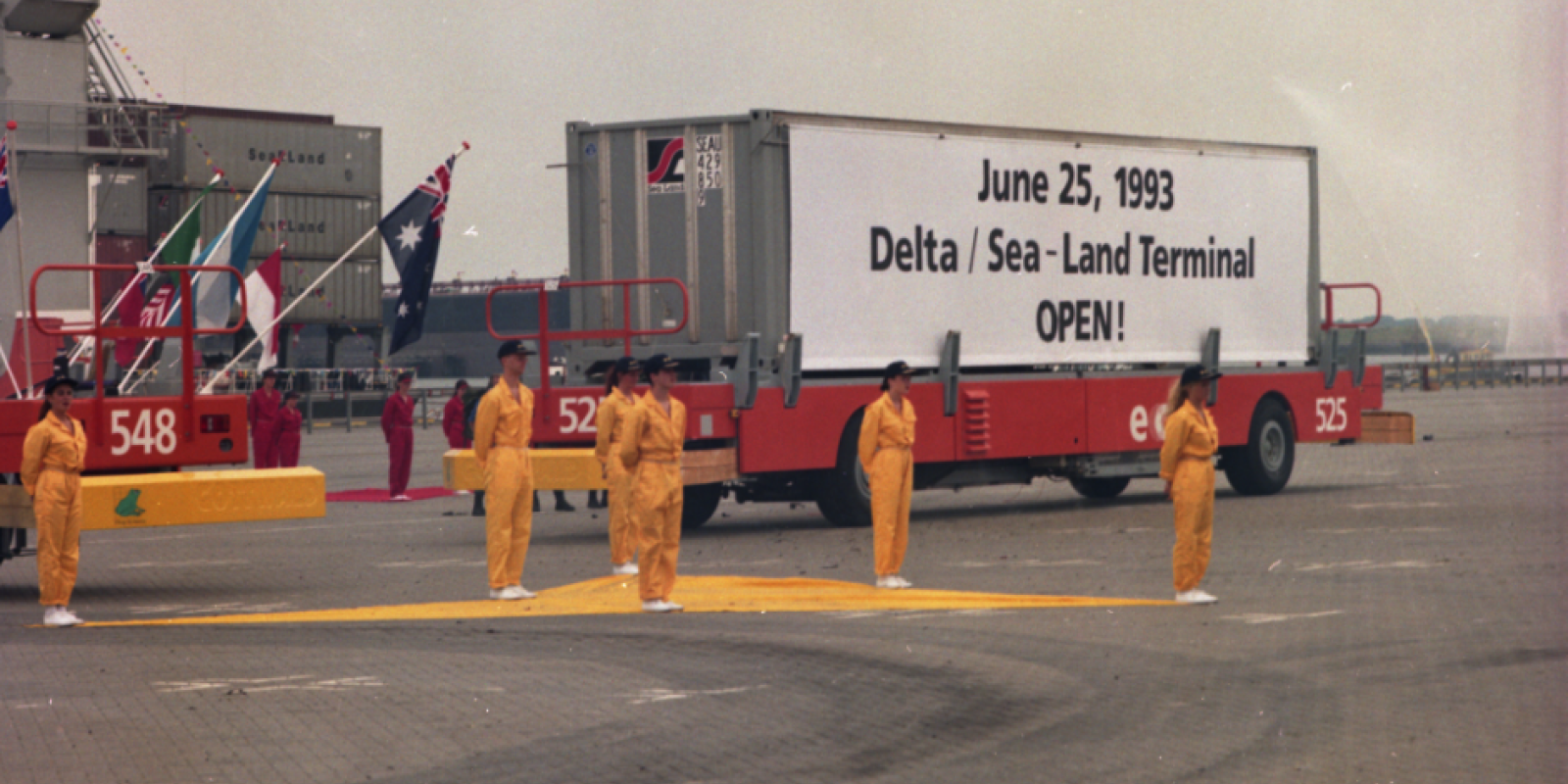
Our Delta Dedicated North Terminal (DDN) is 30 years old. Three decades ago, on the 25th of June 1993, the then Queen Beatrix performed the opening ceremony. The Queen attended for a very good reason. The Delta/Sea-Land Terminal – as the DDN was known back then – was the very first automated terminal in the world. This innovation put ECT way ahead of its time!
Automatic Guided Vehicles (AGV) that drive their routes on the quay 24/7 and Automatic Stacking Cranes (ASC) that enter and leave the stack in a constant rhythm. Quite standard for everyone at today’s ECT. All our terminals are automated. Any staff who joined ECT in the 21st century does not know any better. All this is thanks to a large group of ECT employees who started working on automation in the 1980s.
Underlying vision
The then director of ECT - Gerrit Wormmeester - was a true visionary. In the traditionally organised port sector, ECT already started exploring the possibilities for automated container handling in 1983. Wormmeester viewed automation as a possible solution for dealing with peaks and troughs in container handling, for rising wage costs and for ever-growing container volumes. In 1983, ECT handled more than one million containers for the first time. All this took place in the Eemhaven, at the then Home Terminal. To accommodate further growth, the construction of the first Delta Terminal (nowadays Hutchison Ports Delta II) had already started on a completely empty peninsula at the Maasvlakte; the Delta Terminal became operational in 1984.
From paper to reality
The Delta Terminal was still fairly conventional in terms of organisation. However, it did already feature the innovative Multi Trailer Systems (MTS) that drove under the quay cranes, after which straddle carriers moved the containers in and out of the stack. The opportunity to actually implement in practice the automation measures that had previously only existed on paper presented itself when the existing contract with Sea-Land came up for renewal. This American shipping line was ECT's largest customer and wanted to further expand. Various European ports were keen to lure away the shipping line when the contract expired in 1990. To prevent this, ECT decided not to focus on offering the lowest rates, but to distinguish itself through customisation and innovation. ECT proposed the construction of a fully automated, state-of-the-art terminal for Sea-Land at the Maasvlakte. After carefully considering the proposal for a long time, Sea-Land finally said yes just before Christmas in 1987. Sea-Land would stay in Rotterdam and accepted ECT's innovative proposal. Like ECT, the shipping line wanted the new container terminal to become an example for the industry.
Five years for realisation
In April 1988, the contract with Sea-Land was signed. It was agreed that the new automated terminal would come on stream in 1993. ECT had five years to realise this! Everything that had been conceived on paper now had to be implemented in practice. AGVs did not exist yet and ASCs were still very basic. A start had to be made with the development of the necessary control software as well. In his capacity as program manager, Joan Rijsenbrij, who was Director of Technology at ECT in 1988, was given full power to fulfil the promises made: the realisation of a completely new terminal, with all civil infrastructure, buildings, eight quay cranes, automated AGVs and ASCs, the terminal control and a functioning labour organisation.
Totally new operational approach
ECT already started testing all new technology on a test site at the Delta Terminal in the summer of 1988. First with one AGV and one ASC separately, then in conjunction, continuously advancing and expanding. The workforce had to be fully reorganised as well. Despite the automation, plenty of ECT personnel was still required on both the sea side and the land side. One distinct difference was that a crane team at the automated terminal consisted of just three people; at a conventional terminal this was eight. At the new terminal, responsibilities were placed as low in the organisation as possible, with a strong focus on teamwork and job rotation. Anyone who operated the crane on day 1 could be on the ship as a radio operator on day 2 and work in the control room on day 3. To realise this completely new way of working, employees were offered extensive training, including courses in logistics and social skills.
The big day!
Step by step, the new terminal was thus built. In late 1992, the first test ships were able to actually moor along the quay. This helped to fix many teething problems in the software. On the 25th of June 1993, the big day finally arrived: the official opening of the Delta/Sea-Land Terminal, with guests of honour Queen Beatrix, Mayor Bram Peper of Rotterdam and Sea-Land CEO John P. Clancey. It was a wonderful show, during which Queen Beatrix performed the opening act with a walkie-talkie from the stands: “Crane operator, I request that you start with the unloading of the ceremonial container – over.” To which the crane operator replied: “Your Majesty, I receive you loud and clear. We're going to start!" With that, the Delta/Sea-Land Terminal was officially commissioned. The very first automated terminal in the world had become a reality.
For this article, we made grateful use of passages from the jubilee book 'Always moving forward – 50 years ECT'.
